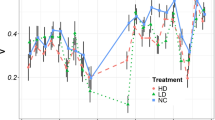Summary
We compared the size distributions of leaves on naturally-occurring crowded and experimentally thinned “uncrowded” individuals of Impatiens pallida in southeastern Pennsylvania. Crowding decreased the number of leaves on individual plants and altered the distribution of leaf size. Crowded individuals had smaller leaves, but the size (length) inequality of the leaf population did not change. The relationships between the height of a plant and the mean and maximum length of its leaves were significantly different for crowded and uncrowded plants. There were weak positive relationships between height and total leaf area, and height and total number of leaves for uncrowded plants, whereas crowded plants showed tighter but curvilinear relationships between these variables. Our results point out the strengths and the limitations of viewing canopies as populations of modules.
Similar content being viewed by others
References
Bazzaz FA, Harper JL (1977) Demographic analysis of growth of Linum usitatissimum New Phytol 78:193–208
Causton DR, Venus JC (1981) The Biometry of Plant Growth. Edward Arnold, London
Dale JE (1982) The Growth of Leaves. Edward Arnold, London
Harper JL (1989a) Canopies as populations. In: Russell G, Marshall B, Jarvis PG (eds) Plant Canopies: Their Growth, Form and Function. Cambridge University Press, Cambridge, pp 105–128
Harper JL (1989b) The value of a leaf. Oecologia 80:53–58
Harper JL, Bell AD (1979) The population dynamics of growth form in organisms with modular construction. In: Anderson RM (ed) Population Dynamics. Blackwell Scientific Publications, Oxford, pp 29–52
Jones M, Harper JL (1987) The influence of neighbours on the growth of trees. I. The demography of buds in Betula pendula. Proc Royal Soc Lond, B 232:1–18
Maillette L (1982) Structural dynamics of silver birch I. The fate of buds. J Appl Ecol 19:203–218
Maillette L (1986) Canopy development, leaf demography and growth dynamics of wheat and three weed species growing in pure and mixed stands. J Appl Ecol 23:929–944
Novoplansky A, Cohen D, Sachs T (1989) Ecological implications of correlative inhibition between plant shoots. Physiol Plant 77:136–140
Silvertown J (1987) Introduction to Plant Population Ecology. (2nd ed) Harlow, Longman
Smith BH (1983) Demography of Floerkea proserpinacoides, a forest-floor annual: I. Density-dependent growth and mortality. J Ecol 71:391–404
Thomas SC, Weiner J (1989) Growth, death and size distribution change in an Impatiens pallida population. J Ecol 77:524–536
Watson MA, Casper BB (1984) Morphogenetic constraints on patterns of carbon distribution in plants. Ann Rev Ecol Syst 15:233–258
Weiner J, Thomas SC (1986) Size variability and competition in plant monocultures. Oikos 47:211–222
Weiner J, Berntson GM, Thomas SC (1990) Competition and growth form in a woodland annual. J Ecol 78:459–469
Winsor J (1983) Persistence by habitat domination in the annual Impatiens capensis (Balsaminaceae). J Ecol 71:451–466
Author information
Authors and Affiliations
Rights and permissions
About this article
Cite this article
Berntson, G.M., Weiner, J. Size structure of populations within populations: leaf number and size in crowded and uncrowded Impatiens pallida individuals. Oecologia 85, 327–331 (1991). https://doi.org/10.1007/BF00320607
Received:
Accepted:
Issue Date:
DOI: https://doi.org/10.1007/BF00320607




